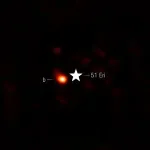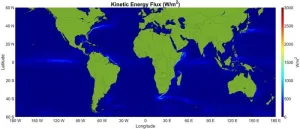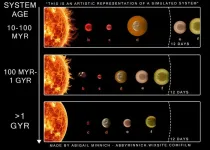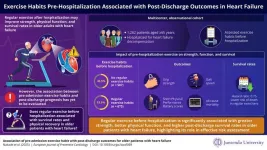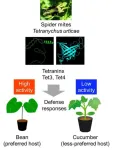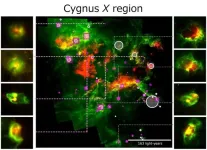(Press-News.org) The James Webb Space Telescope has captured its first direct images of carbon dioxide in a planet outside the solar system in HR 8799, a multiplanet system 130 light-years away that has long been a key target for planet formation studies.
The observations provide strong evidence that the system’s four giant planets formed in much the same way as Jupiter and Saturn, by slowly building solid cores. They also confirm Webb can do more than infer atmospheric composition from starlight measurements—it can directly analyze the chemistry of exoplanet atmospheres.
“By spotting these strong carbon dioxide features, we have shown there is a sizable fraction of heavier elements, such as carbon, oxygen, and iron, in these planets’ atmospheres. Given what we know about the star they orbit, that likely indicates they formed via core accretion, which for planets that we can directly see is an exciting conclusion,” said William Balmer, a Johns Hopkins University astrophysicist who led the work.
An analysis of the observations, which also included a system 96 light-years away called 51 Eridani, appears in The Astrophysical Journal.
HR 8799 is a young system about 30 million years old, a fraction of our solar system’s 4.6 billion years. Still hot from their violent formation, HR 8799 planets emit large amounts of infrared light that give scientists valuable data on how their formation compares to that of stars or brown dwarfs.
Giant planets can take shape in two ways: by slowly building solid cores that attract gas, like our solar system, or by rapidly collapsing from a young star’s cooling disk into massive objects. Knowing which model is more common can give scientists clues to distinguish between the types of planets they find in other systems.
“Our hope with this kind of research is to understand our own solar system, life, and ourselves in comparison to other exoplanetary systems, so we can contextualize our existence,” Balmer said. “We want to take pictures of other solar systems and see how they’re similar or different when compared to ours. From there, we can try to get a sense of how weird our solar system really is—or how normal.”
Very few exoplanets have been directly imaged, as distant planets are many thousands of times fainter than their stars. By capturing direct images at specific wavelengths only accessible with Webb, the team is paving the way for more detailed observations to determine whether the objects they see orbiting other stars are truly giant planets or objects such as brown dwarfs, which form like stars but don’t accumulate enough mass to ignite nuclear fusion.
“We have other lines of evidence that hint at these four HR 8799 planets forming using this bottom-up approach” said Laurent Pueyo, an astronomer at the Space Telescope Science Institute who co-led the work. “How common is this for long period planets we can directly image? We don’t know yet, but we're proposing more Webb observations, inspired by our carbon dioxide diagnostics, to answer that question.”
The achievement was made possible by Webb’s coronagraphs, which block light from bright stars as happens in a solar eclipse to reveal otherwise hidden worlds. This allowed the team to look for infrared light in wavelengths that reveal specific gases and other atmospheric details.
Targeting the 3-5 micrometer wavelength range, the team found that the four HR 8799 planets contain more heavy elements than previously thought, another hint that they formed in the same way as our solar system’s gas giants. The observations also revealed the first-ever detection of the innermost planet, HR 8799 e, at a wavelength of 4.6 micrometers, and 51 Eridani b at 4.1 micrometers, showcasing Webb’s sensitivity in observing faint planets close to bright stars.
In 2022, one of Webb’s key observation techniques indirectly detected carbon dioxide in another exoplanet, called WASP-39 b, by tracking how its atmosphere altered starlight when it passed in front of its star.
“This is what scientists have been doing for transiting planets or isolated brown dwarfs since the launch of JWST,” Pueyo said.
Rémi Soummer, who directs the Optics Laboratory at the Space Telescope Science Institute and previously led Webb’s coronagraph operations, added: “We knew JWST could measure colors of the outer planets in directly imaged systems. We have been waiting for 10 years to confirm that our finely tuned operations of the telescope would also allow us to access the inner planets. Now the results are in, and we can do interesting science with it.”
The team hopes to use Webb’s coronagraphs to analyze more giant planets and compare their composition to theoretical models.
“These giant planets have pretty big implications,” Balmer said. “If you have these huge planets acting like bowling balls running through your solar system, they can either really disrupt, protect, or do a little bit of both to planets like ours, so understanding more about their formation is a crucial step to understanding the formation, survival, and habitability of Earth-like planets in the future.”
Other authors include Jens Kammerer of the European Southern Observatory; Marshall D. Perrin, Julien H. Girard, Roeland P. van der Marel, Jeff A. Valenti, Joshua D. Lothringer, Kielan K. W. Hoch, and Rèemi Soummer of the Space Telescope Science Institute; Jarron M. Leisenring of University of Arizona; Kellen Lawson of NASA-Goddard Space Flight Center; Henry Dennen of Amherst College; Charles A. Beichman of NASA Exoplanet Science Institute; Geoffrey Bryden, Jorge Llop-Sayson of Jet Propulsion Laboratory; Nikole K. Lewis of Cornell University; Mathilde Mâlin of Johns Hopkins; Isabel Rebollido, Emily Rickman of the European Space Agency; Mark Clampin of NASA Headquarters; and C. Matt Mountain of the Association of Universities for Research in Astronomy.
This research was supported by NASA through grant 80NSSC20K0586, with additional support from NASA through the JWST/NIRCam project, contract number NAS5-02105, and the Advanced Research Computing at Hopkins (ARCH) core facility (rockfish.jhu.edu), which is supported by the National Science Foundation (NSF) grant number OAC1920103. Based on observations with the NASA/ESA/CSA JWST, obtained at the Space Telescope Science Institute, which is operated by AURA Inc., under NASA contract NAS 5-03127.
END
Webb telescope captures its first direct images of carbon dioxide outside solar system
The images suggest key giant exoplanets likely formed like Jupiter and Saturn
2025-03-17
ELSE PRESS RELEASES FROM THIS DATE:
NIH-sponsored trial of Lassa vaccine opens
2025-03-17
A National Institutes of Health (NIH)-sponsored clinical trial of a candidate vaccine to prevent Lassa fever has begun enrolling participants at the University of Maryland School of Medicine, Baltimore. Lassa fever is a viral hemorrhagic disease that can be fatal and that causes permanent hearing loss in up to one-third of those who contract it. Lassa virus is spread by rodents, known as multimammate rats, that are native to many countries in West Africa. The virus can also be spread from person to person. Currently, there are no specific drug treatments or vaccines for Lassa fever. NIH’s National Institute of Allergy and ...
Pro-life people partly motivated to prevent casual sex, study finds
2025-03-17
(Note: The following press release was prepared by Brunel University of London.)
Abortion is murder – the emotive rallying cry popular with pro-life campaigners keen to convert others to their cause. But what if opposition to abortion isn’t all about sanctity-of-life concerns, and instead at least partly about discouraging casual sex?
That’s what psychology researchers found in experiments designed to test what really drives anti-abortion attitudes in the USA. The study, published today in ...
Top locations for ocean energy production worldwide revealed
2025-03-17
As global electricity demand grows, traditional energy sources are under strain. Oceans, which cover more than 70% of Earth’s surface, offer vast potential for clean energy from renewable resources such as ocean currents and waves.
However, marine renewable energy development is still in its early stages compared to wind and solar power. One challenge is identifying the most feasible and economically viable locations for ocean current energy projects. While many studies have focused on regional ocean current energy resource assessment, a global evaluation based on actual data has been lacking – until now.
Using more ...
New AI model analyzes full night of sleep with high accuracy in largest study of its kind
2025-03-17
New York, NY [March 17, 2025]—Researchers at the Icahn School of Medicine have developed a powerful AI tool, built on the same transformer architecture used by large language models like ChatGPT, to process an entire night’s sleep. To date, it is one of the largest studies, analyzing 1,011,192 hours of sleep. Details on their findings were reported in the March 13 online issue of the journal Sleep [https://doi.org/10.1093/sleep/zsaf061].
The model, called patch foundational transformer for sleep (PFTSleep), ...
Combination of cosmic processes shapes the size and location of sub-Neptunes
2025-03-17
UNIVERSITY PARK, Pa. — A combination of cosmic processes shapes the formation of one of the most common types of planets outside of our solar system, according to a new study led by researchers at Penn State. The research team used data from NASA’s Transiting Exoplanet Survey Satellite (TESS) to study young sub-Neptunes — planets bigger than Earth but smaller than Neptune — that orbit close to their stars. The work provides insights into how these planets might migrate inward or lose their atmosphere during their early stages.
A paper describing the ...
New study shows regular exercise pre-hospitalization is linked to better outcomes in heart failure
2025-03-17
Heart failure is a major health concern, especially for ageing populations—it significantly increases mortality rates, and severely impacts quality of life for those affected. Exercise therapy has been shown to be particularly effective for patients with heart failure. Previous research, however, has mainly examined the benefits of exercise after a diagnosis of heart failure. There is a considerable gap when it comes to our understanding of the role that exercise plays before a patient with heart failure is hospitalized.
Now, in a recent study published in the European Journal of Preventive Cardiology on 19 February 2025, researchers from Japan have explored the link between ...
New discovery in plant–pest warfare could lead to sustainable farming solutions
2025-03-17
As global food demand continues to increase, effective pest control remains one of agriculture’s most pressing challenges. Worldwide, farmers apply nearly 4 million tons of chemical pesticides annually to protect their crops, representing a $60 billion industry. While these compounds have significantly boosted agricultural productivity, their widespread use has raised concerns regarding environmental impact, health risks, and the long-term sustainability of modern farming.
The two-spotted spider mite, Tetranychus urticae, exemplifies the limitations of conventional pesticide-based pest management in agriculture and horticulture. ...
Make Indian sign language an official language and open more schools for deaf and hard-of-hearing students, Cambridge study advises Indian government
2025-03-17
University of Cambridge media release
Make Indian Sign Language an official language and open more schools for deaf and hard-of-hearing students, Cambridge study advises Indian Government
UNDER STRICT EMBARGO UNTIL 15:30 INDIA STANDARD TIME / 10:00 UK TIME / 06:00 US ET ON MONDAY 17TH MARCH 2025
Around one in five (over 19%) of India’s deaf and hard-of-hearing children were out-of-school in 2014, according to a survey conducted for the Indian Government.* A new study calls on the Government to address this ongoing educational crisis by recognising ...
Deep dive into space turns up new Spitzer bubbles
2025-03-17
To learn more about the deepest reaches of our own galaxy and the mysteries of star formation, Japanese researchers have created a deep learning model. The Osaka Metropolitan University-led team used artificial intelligence to pore through the vast amounts of data being acquired from space telescopes, finding bubble-like structures that had not been included in existing astronomical databases.
The Milky Way galaxy we live in, like other galaxies in the universe, has bubble-like structures formed mainly during the birth and activity of high-mass stars. These so-called Spitzer bubbles hold important clues to understanding the process of star formation and galaxy evolution.
Graduate School of ...
Attention can be used to drive cooperation – new study
2025-03-17
Our ability to cooperate with others may be influenced by how our attention is captured and directed, as much as by how altruistic we are feeling.
According to a new study by researchers at the University of Birmingham jointly with the University of Zurich, choices made for individual reward or cooperatively for a joint reward can be influenced by presenting information to participants in configurations that naturally draw their attention. The results are published today in Communications Psychology.
Cooperation – defined as the ability of individuals to incur a personal cost for the benefit ...
LAST 30 PRESS RELEASES:
When is it time to jump? The boiling frog problem of AI use in physics education
Twitter data reveals partisan divide in understanding why pollen season's getting worse
AI is quick but risky for updating old software
Revolutionizing biosecurity: new multi-omics framework to transform invasive species management
From ancient herb to modern medicine: new review unveils the multi-targeted healing potential of Borago officinalis
Building a global scientific community: Biological Diversity Journal announces dual recruitment of Editorial Board and Youth Editorial Board members
Microbes that break down antibiotics help protect ecosystems under drug pollution
Smart biochar that remembers pollutants offers a new way to clean water and recycle biomass
Rice genes matter more than domestication in shaping plant microbiomes
Ticking time bomb: Some farmers report as many as 70 tick encounters over a 6-month period
Turning garden and crop waste into plastics
Scientists discover ‘platypus galaxies’ in the early universe
Seeing thyroid cancer in a new light: when AI meets label-free imaging in the operating room
Neutrophil-to-lymphocyte ratio may aid risk stratification in depressive disorder
2026 Seismological Society of America Annual Meeting
AI-powered ECG analysis offers promising path for early detection of chronic obstructive pulmonary disease, says Mount Sinai researchers
GIMM uncovers flaws in lab-grown heart cells and paves the way for improved treatments
Cracking the evolutionary code of sleep
Medications could help the aging brain cope with surgery, memory impairment
Back pain linked to worse sleep years later in men over 65, according to study
CDC urges ‘shared decision-making’ on some childhood vaccines; many unclear about what that means
New research finds that an ‘equal treatment’ approach to economic opportunity advertising can backfire
Researchers create shape-shifting, self-navigating microparticles
Science army mobilizes to map US soil microbiome
Researchers develop new tools to turn grain crops into biosensors
Do supervised consumption sites bring increased crime? Study suggests that’s a myth
New mass spec innovation could transform research
Maternal nativity, race, and ethnicity and infant mortality in the US
Migration-related trauma among asylum seekers exposed to the migrant protection protocols
Jupiter’s moon Europa has a seafloor that may be quiet and lifeless
[Press-News.org] Webb telescope captures its first direct images of carbon dioxide outside solar systemThe images suggest key giant exoplanets likely formed like Jupiter and Saturn

